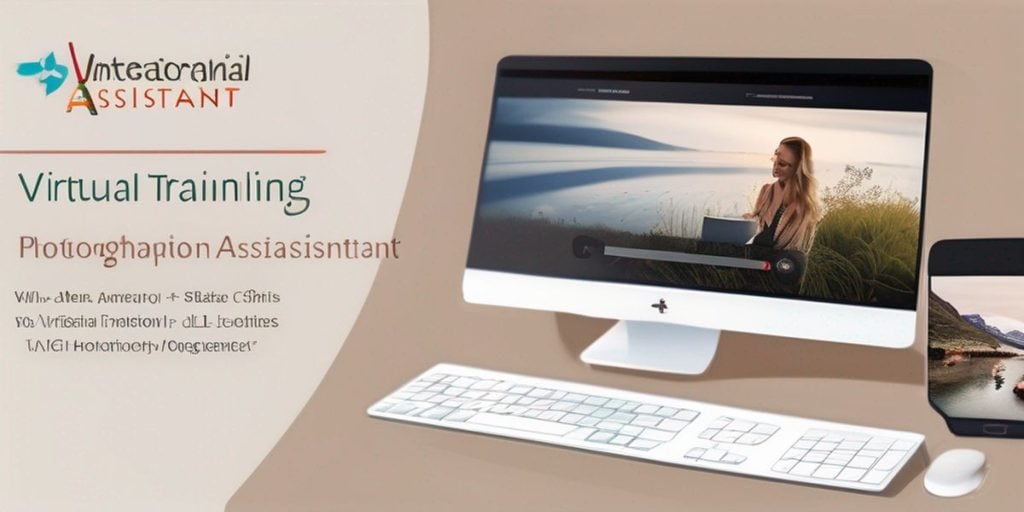In today’s globalized economy, hiring an overseas virtual assistant (VA) has become a common practice for businesses looking to optimize costs and tap into a wider talent pool. However, the decision to provide training for these international team members is critical to ensuring their effectiveness and integration into the company’s operations. This article explores the multifaceted aspects of training overseas VAs, examining the challenges, benefits, and strategic approaches to maximizing their potential while aligning with business goals.
Key Takeaways
Providing training to overseas virtual assistants can address communication challenges, cultural nuances, and ensure quality control in their work output.
Assessing the skill levels and task complexity is crucial in determining the extent and type of training required for an overseas VA.
Training can lead to enhanced performance, reduced need for constant supervision, and long-term cost savings despite the initial investment.
Effective training strategies include leveraging technology for distance learning, creating comprehensive guides, and scheduling regular check-ins to overcome time zone and language barriers.
Measuring the impact of training is essential for continuous improvement, and should involve setting benchmarks, conducting regular performance reviews, and soliciting feedback.
Understanding the Role of Training for Overseas Virtual Assistants

Communication Challenges
Integrating an Overseas Virtual Assistant into your operations requires a strategic approach. Establishing clear communication channels and setting realistic expectations are crucial. You’ll likely face hurdles such as language barriers and time zone differences, which can impede the flow of information and lead to misunderstandings. To mitigate these challenges, consider the following steps:
Implement a robust onboarding process.
Use communication tools that support real-time translation.
Schedule regular meetings within mutually agreeable hours.
Quality Control
When you hire an overseas virtual assistant, assessing their work quality becomes paramount. Due to the distance, you may not be able to monitor their tasks as closely as you would with a local assistant. Effective delegation in sales, for example, involves training, trust, monitoring, and feedback. Here’s a succinct table outlining potential quality issues and solutions:
Issue | Solution |
|---|---|
Inconsistent work quality | Provide detailed guidelines and checklists. |
Misunderstandings due to language | Offer language and communication training. |
Slow response times | Set clear deadlines and use project management tools. |
Cultural and Language Nuances
Understanding cultural and language nuances is essential for smooth collaboration with your overseas assistant. This knowledge helps in avoiding miscommunications and ensures that your assistant can effectively interact with your clients and team. To enhance cultural understanding:
Provide cultural sensitivity training.
Encourage open discussions about cultural differences.
Share resources about your own country’s business etiquette.
By investing in training, you’re not only improving the individual’s performance but also contributing to a more cohesive and efficient remote team.
Evaluating the Need for Training

When you’re considering the integration of an overseas virtual assistant into your team, it’s crucial to evaluate the need for training. This step ensures that your assistant is well-equipped to handle the tasks at hand and aligns with your business objectives.
Assessing Skill Levels
Begin by assessing the skill levels of your potential virtual assistant. You’ll want to review their previous experience, technical abilities, and familiarity with the tools and processes your business uses. Create a checklist of essential skills and compare it against the VA’s proficiencies to identify any gaps that training could fill.
Determining Task Complexity
Next, consider the complexity of the tasks you’ll be assigning. Simple, repetitive tasks may require minimal training, while more complex, specialized tasks could necessitate a comprehensive training program. Use the table below to categorize tasks and determine the level of training needed:
Task Complexity | Training Requirement |
|---|---|
Low | Minimal |
Moderate | Moderate |
High | Extensive |
Setting Expectations
Finally, setting clear expectations is vital for both you and your virtual assistant. Outline the standards of performance, communication protocols, and deadlines. This clarity will help your VA understand the role’s requirements and the level of autonomy they have, which can influence the training approach.
Review the VA’s qualifications
Match tasks with skill level
By taking the time to evaluate the need for training, you’re not only setting your virtual assistant up for success but also ensuring a smoother workflow for your business.
Benefits of Providing Training

When you invest in training for your overseas virtual assistant, you’re not just improving their individual performance; you’re enhancing the overall productivity of your business. Let’s explore the advantages you’ll gain from this decision.
Enhanced Performance
By providing training, you equip your virtual assistant with the latest skills and knowledge necessary to excel. This leads to improved accuracy and efficiency in their work, which can be particularly beneficial when they’re handling complex tasks or using specialized software.
Increased skill set
Better task execution
Higher quality outcomes
Reduced Supervision
Training your virtual assistant means they’ll require less oversight from you. They’ll be more autonomous, understanding how to prioritize and manage tasks effectively. This newfound independence allows you to focus on high-value activities within your business.
Autonomy in task management
Less time spent on micromanagement
More time for strategic business planning
Long-term Cost Savings
While there’s an upfront cost to training, the long-term savings are significant. A well-trained virtual assistant is less likely to make costly mistakes and more likely to stay with your company, reducing turnover expenses.
Aspect | Without Training | With Training |
|---|---|---|
Error Rate | High | Low |
Productivity | Variable | Consistent |
Employee Retention | Lower | Higher |
Investing in your virtual assistant’s development is an investment in your business’s future. It’s a strategic move that pays dividends in efficiency and stability.
The Cost-Benefit Analysis of Training Overseas Assistants

Immediate vs. Long-term Expenses
When you’re considering training your overseas virtual assistant, it’s crucial to weigh the immediate costs against the potential long-term savings. Initially, you might face expenses such as training materials, dedicated time for instruction, and possible downtime as your assistant gets up to speed. However, these costs should be measured against the future benefits of having a well-trained assistant who can work independently and efficiently.
Expense Type | Immediate Cost | Long-term Benefit |
|---|---|---|
Training Materials | $X | Improved VA Skills |
Instruction Time | $Y | Reduced Error Rate |
Downtime | $Z | Increased Productivity |
Training as an Investment
Think of training as an investment in your business’s operational efficiency. By equipping your virtual assistant with the necessary skills and knowledge, you’re not only enhancing their ability to perform tasks but also building a foundation for growth. A well-trained VA can adapt to new challenges, reducing the need for future training and recruitment.
Enhanced skill set for complex tasks
Greater adaptability to business changes
Long-term reduction in recruitment costs
Comparing Local vs. Overseas Training Costs
When you compare the costs of training a local assistant versus an overseas one, you’ll often find that the latter can be more cost-effective. This is due to the lower cost of living in many countries where overseas VAs reside, which translates into lower wage expectations and, consequently, lower training costs. However, this should be balanced with the quality of training and the potential communication barriers that may arise.
Ensure that the training you provide is comprehensive and takes into account any cultural or language differences that could impact the effectiveness of your overseas assistant.
Strategies for Effective Training

To ensure your overseas virtual assistant is well-equipped to handle their tasks, you’ll need to adopt some effective training strategies. Leveraging technology is key in this digital age. Utilize video conferencing tools, shared documents, and online training modules to create an interactive and accessible learning environment.
Creating comprehensive guides can streamline the training process. These should include:
Step-by-step instructions
Best practices
FAQs
Troubleshooting tips
Scheduling regular check-ins is crucial for maintaining open lines of communication and providing ongoing support. These sessions can be used to address any questions, provide feedback, and adjust training as needed.
Remember, the goal is to empower your virtual assistant with the knowledge and skills they need to perform effectively and independently.
Challenges and Solutions in Training International VAs

Time Zone Differences
Training an overseas virtual assistant means you’ll likely face time zone differences. To manage this, consider these steps:
Schedule training sessions at mutually convenient times.
Use asynchronous training materials like recorded videos or written guides.
Implement a flexible training timeline to accommodate the time difference.
Language Barriers
Language barriers can impede the training process. To overcome this:
Ensure your VA has a proficient level of English or provide materials in their native language.
Use visual aids and simple language to clarify complex concepts.
Consider hiring a translator for initial training sessions if necessary.
Cultural Sensitivity Training
Understanding cultural nuances is crucial for effective communication. Here’s how you can integrate cultural sensitivity into your training:
Include a section on cultural norms and business etiquette in your training program.
Encourage open dialogue about cultural differences and how they may affect work.
Provide examples of successful cross-cultural collaborations to inspire and guide your VA.
Remember, investing in comprehensive training for your international VA can lead to a more harmonious and productive working relationship.
Measuring the Impact of Training on VA Performance

Setting Benchmarks
To effectively measure the impact of training, start by establishing clear benchmarks. These should reflect the core tasks and workflows your virtual assistant will handle. Use structured data to track progress over time. For instance:
Task | Pre-Training Accuracy | Post-Training Accuracy |
|---|---|---|
Email Management | 75% | 95% |
Data Entry | 80% | 99% |
Regular Performance Reviews
Conduct regular performance reviews to assess improvements and identify areas for further development. This ensures your virtual assistant’s growth aligns with your business objectives, ultimately increasing productivity and generating more revenue.
Review task completion rates
Assess quality of work
Discuss feedback and set new goals
Feedback and Continuous Improvement
Encourage an open dialogue for feedback, fostering an environment of continuous improvement. This not only helps in fine-tuning the training process but also in maintaining a high level of performance.
By consistently applying these measures, you can ensure that the training provided to your overseas virtual assistant translates into tangible benefits for your business.
When to Consider Hiring an Overseas Virtual Assistant

Cost vs. Expertise Trade-off
When you’re looking to balance your budget without compromising on skill, hiring an overseas virtual assistant (VA) can be a strategic move. You might find that advanced technical skills are more affordable when sourced internationally, allowing you to allocate funds to other business areas.
Task Flexibility and Deadlines
If your projects have flexible timelines and the tasks at hand don’t require immediate attention, an overseas VA could be ideal. The absence of strict deadlines means you can benefit from lower hourly rates, even if it entails waiting a bit longer for responses or task completion.
Client Proximity and Cultural Alignment
Consider the proximity of your VA to your client base. If cultural alignment and local knowledge are crucial for your operations, weigh these factors carefully. However, if these aspects are less critical, the diverse selection of VAs from countries with a strong virtual assistant industry might offer you a valuable global perspective.
Leverage technology for personalized bulk email campaigns
Prioritize high-value tasks with automation
Train sales reps to focus on revenue-generating activities
Now that you are aware of the pros and cons of hiring an overseas virtual assistant, you should be able to make the best choice for your business needs.
Frequently Asked Questions
What are the main challenges when training an overseas virtual assistant?
The main challenges include communication barriers due to language and cultural differences, time zone discrepancies which can affect coordination, and the complexity of ensuring quality control from a distance.
How can providing training to an overseas virtual assistant benefit my business?
Training enhances the assistant’s performance, reduces the need for constant supervision, and can lead to long-term cost savings by ensuring tasks are completed correctly and efficiently.
When is the right time to hire an international virtual assistant?
The right time to hire an international virtual assistant is when you are seeking cost savings, have tasks without strict deadlines, or require advanced technical skills that are expensive locally.
What are some effective strategies for training international virtual assistants?
Effective strategies include leveraging technology for remote training, creating comprehensive guides and resources, and scheduling regular check-ins to monitor progress and provide feedback.
What should I consider when conducting a cost-benefit analysis of training overseas assistants?
Consider the immediate and long-term expenses of training, view training as an investment in quality and efficiency, and compare the costs and benefits of training overseas versus local assistants.
How can I measure the impact of training on my overseas virtual assistant's performance?
Measure the impact by setting clear benchmarks, conducting regular performance reviews, and fostering an environment of feedback and continuous improvement.
